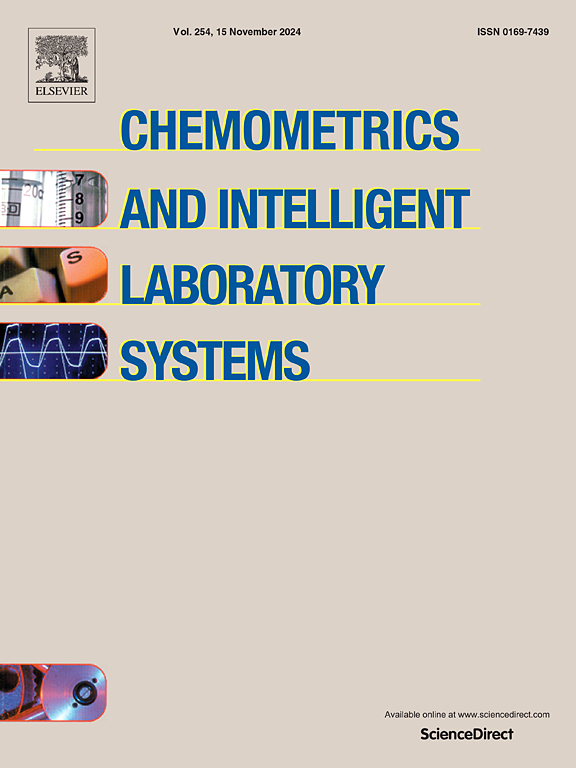通过特征选择优化软传感器成本:葡萄酒等级预测中感官和化学参数的比较研究
IF 3.8
2区 化学
Q2 AUTOMATION & CONTROL SYSTEMS
Chemometrics and Intelligent Laboratory Systems
Pub Date : 2025-04-15
DOI:10.1016/j.chemolab.2025.105404
引用次数: 0
摘要
传统的葡萄酒等级评估通常由世界知名葡萄酒专家进行,由于其限制性和耗时的性质,新兴酒庄处于不利地位。本研究提出了一种使用软传感器预测葡萄酒等级的替代方法,通过各种机器学习方法研究化学和感官评估方法的成本效益。23种不同的葡萄酒样品一式两份(总共46瓶新西兰黑皮诺葡萄酒)的数据集,按照Jukes-Stelzer系统的所有五星级分类,使用13种化学参数和35种感官属性进行分析。该研究采用了分类算法,包括naïve贝叶斯、k近邻、决策树和支持向量机,来预测葡萄酒的等级。此外,多种特征选择方法——如PCA距离分析、基于集成树的特征选择、基于决策树的特征选择、Fisher评分、relief-F评分分析和单向方差分析——被用于识别最显著的预测变量,同时最小化分析成本。结果表明,化学参数,特别是与葡萄酒颜色和总酚类物质相关的化学参数,是葡萄酒等级的有力指标,使用所有13种化学参数的软传感器的预测精度高达93.48%。感官属性,特别是橡木的影响和与葡萄酒储存有关的三级香气,也被证明是有效的预测因素。利用所有35个感官属性的软传感器的准确率达到97.83%。通过特征选择方法,成本可以降低高达100%,同时保持可接受的预测精度(65%以上)。同样,使用感官属性作为输入数据,准确率达到65%以上,同时成本降低97%。此外,在仅进行一次化学测量并且由单个葡萄酒专家评估感官属性的情况下,比较成本分析显示,对于高精度预测,感官属性更经济(> 70%),而对于中等精度水平的预测,化学参数被证明更具成本效益(< 70%)。对于更高的精度要求(> 70%),感官评估成为最佳选择,提供高精度和成本效益。本研究提出了一个具有成本效益的葡萄酒等级预测方法的实用框架,可以使现有和新兴的葡萄酒生产商受益,为传统的基于专家的评估系统提供了一个可访问的替代方案。本文章由计算机程序翻译,如有差异,请以英文原文为准。
Optimizing soft sensor costs through feature selection: A comparative study of sensory and chemical parameters in wine grade prediction
Traditional wine grade evaluation, typically conducted by world-renowned wine experts, was found to disadvantage emerging wineries due to its restrictive and time-consuming nature. This study proposed an alternative approach using soft sensors to predict wine grades, investigating the cost-effectiveness of both chemical and sensory evaluation methods through various machine learning approaches. A dataset of 23 unique wine samples in duplicate (totaling 46 bottles of New Zealand Pinot Noir wines), classified across all five stars of the Jukes-Stelzer system, was analyzed using 13 chemical parameters and 35 sensory attributes. The research employed classification algorithms, including naïve Bayes, k-nearest neighbors, decision trees, and support vector machines, to predict wine grades. Additionally, multiple feature selection methods—such as PCA distance analysis, ensemble tree-based feature selection, decision tree-based feature selection, Fisher score, relief-F score analysis, and one-way ANOVA—were used to identify the most significant predictive variables while minimizing analytical costs. Results demonstrated that chemical parameters, particularly those related to wine color and total phenolics, served as strong indicators of wine grade, with soft sensors using all 13 chemical parameters achieving prediction accuracies up to 93.48 %. Sensory attributes, particularly oak influence and tertiary aromas related to wine storage, also proved to be effective predictors. Soft sensors utilizing all 35 sensory attributes achieved accuracies of 97.83 %. Through feature selection methods, costs could be reduced by up to 100 % while maintaining acceptable prediction accuracy (above 65 %). Similarly, accuracies above 65 % were achieved using sensory attributes as input data, alongside a 97 % cost reduction. Additionally, in scenarios where chemical measurements were taken only once and sensory attributes were evaluated by a single wine expert, a comparative cost analysis revealed that sensory attributes were more economical for high-accuracy predictions (>70 %), while chemical parameters proved more cost-effective for moderate accuracy levels (<70 %). For higher accuracy requirements (>70 %), sensory evaluation emerged as the optimal choice, offering both high accuracy and cost-effectiveness. This study proposed a practical framework for cost-effective wine grade prediction methods that could benefit both established and emerging wine producers, offering an accessible alternative to traditional expert-based evaluation systems.
求助全文
通过发布文献求助,成功后即可免费获取论文全文。
去求助
来源期刊
CiteScore
7.50
自引率
7.70%
发文量
169
审稿时长
3.4 months
期刊介绍:
Chemometrics and Intelligent Laboratory Systems publishes original research papers, short communications, reviews, tutorials and Original Software Publications reporting on development of novel statistical, mathematical, or computer techniques in Chemistry and related disciplines.
Chemometrics is the chemical discipline that uses mathematical and statistical methods to design or select optimal procedures and experiments, and to provide maximum chemical information by analysing chemical data.
The journal deals with the following topics:
1) Development of new statistical, mathematical and chemometrical methods for Chemistry and related fields (Environmental Chemistry, Biochemistry, Toxicology, System Biology, -Omics, etc.)
2) Novel applications of chemometrics to all branches of Chemistry and related fields (typical domains of interest are: process data analysis, experimental design, data mining, signal processing, supervised modelling, decision making, robust statistics, mixture analysis, multivariate calibration etc.) Routine applications of established chemometrical techniques will not be considered.
3) Development of new software that provides novel tools or truly advances the use of chemometrical methods.
4) Well characterized data sets to test performance for the new methods and software.
The journal complies with International Committee of Medical Journal Editors'' Uniform requirements for manuscripts.

 求助内容:
求助内容: 应助结果提醒方式:
应助结果提醒方式:


